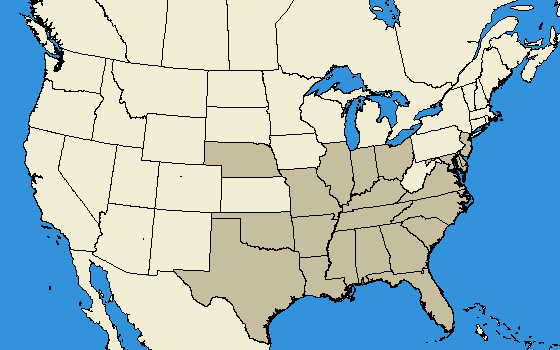You see, while scavenging through a pile of cement rubble for border material for one of my new raised beds, I came across my first Kansas widow. Immediately I exclaimed, "Awesome! My first Western Black Widow!" (okay, maybe I didn't, but I thought it). Moments later, however, that creeping little voice in my head reminded me that I have never actually bothered to learn the distinguishing characteristics between the three black widows possible in the U.S. and I that I didn't even have a clue about their range overlap. BugGuide quickly helped me with this dilemma. So, here is a quick summary of what I learned that will help me (and maybe you!) feel more confident in future black widow identifications.
1. Referring to some BugGuide info and a few other internets resources, there is some degree of range overlap for the three species of widow. Though it seems like the Northern and Southern widows try to stay mostly Eastern.
 |
| Confirmed occurrences (dark brown) of the Western Black Widow, courtesy of BugGuide |
 |
| Confirmed occurrences of the Southern Black Widow, courtesy of BugGuide |
 |
| Confirmed occurrences of the Northern Black Widow, courtesy of BugGuide |
2. Dorsal markings are not as important for identification as I initially thought. Southern widows tend to be all black overall (aside from the hourglass) at maturity. Mature Western widows also gain an overall black or even "shiny brown" appearance. Northern widows can apparently have a row of red spots and white bands dorsally even when mature. However, all immature widows can show a huge variation in the presence and degree of dorsal red and white markings when immature. Take these images for example:
I photographed this sizable specimen on top of Stegall Mountain in Missouri. I am going to assume this is a mature Northern widow, remember the thing about Northerns retaining dorsal red spots?
 |
| Stegall Mountain, Peck Ranch Conservation Area, Missouri |
 |
| Rock Bridge Memorial State Park, Columbia, Missouri |
 |
| Immature Western Black Widow, Holcomb, Kansas |
 |
| Western Black Widow (specimen in question) hourglass, best I could get inside a clear container. |
 |
| Southern Black Widow hourglass, Chris Wirth, BugGuide |
 |
| Northern Black Widow hourglass, Chris Wirth, BugGuide |
nice.
ReplyDelete